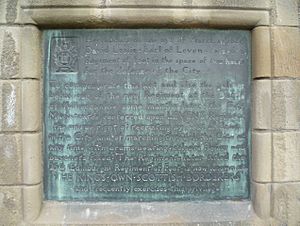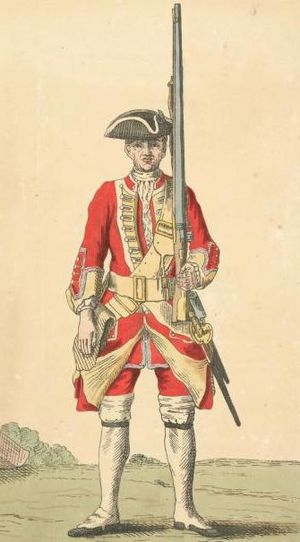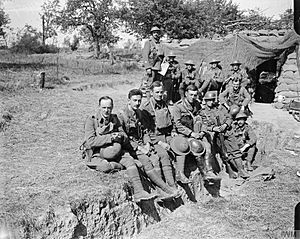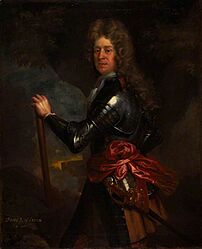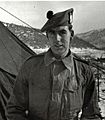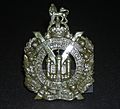King's Own Scottish Borderers facts for kids
Quick facts for kids King's Own Scottish Borderers |
|
|---|---|
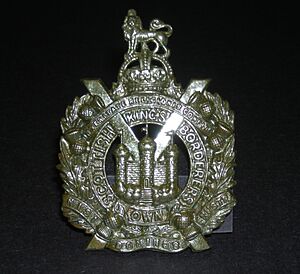
Cap badge
|
|
| Active | 1689 – 1 August 2006 |
| Allegiance | |
| Branch | |
| Type | Line Infantry |
| Size | One battalion |
| Part of | Scottish Division |
| Garrison/HQ | Berwick Barracks, Berwick-upon-Tweed |
| Motto(s) | In Veritate Religionis Confido (I put my trust in the truth of religion) Nisi Dominus Frustra (Without the Lord, everything is in vain) |
| Anniversaries | Minden – 1 August |
| Commanders | |
| Last Colonel-in-Chief | Princess Alice, Duchess of Gloucester, GCB, CI, GCVO, GBE |
| Notable commanders |
John Cooper (Operation Banner, 1993–97) |
| Insignia | |
| Tartan | Leslie (trews) Royal Stewart (pipers kilts and plaids) |
The King's Own Scottish Borderers (often called KOSBs) was a famous line infantry regiment in the British Army. It was part of the Scottish Division. This regiment had a long history, serving for over 300 years.
In 2006, the KOSBs joined with several other Scottish regiments to create the Royal Regiment of Scotland. After a few months, the KOSBs battalion merged with the Royal Scots Battalion. This new group became known as the Royal Scots Borderers.
Contents
A Look Back: The KOSBs' History
Starting the Regiment in Scotland

The King's Own Scottish Borderers began on March 18, 1689. It was started by David Leslie, 3rd Earl of Leven. His goal was to protect Edinburgh from forces loyal to King James VII. It's said that 800 men joined up in just two hours!
The regiment's first fight was at the Battle of Killiecrankie in July 1689. Even though the army they were with lost, the KOSBs played a key role. They fired a shot that killed the enemy leader, ending King James II's attempt to reclaim his throne in Scotland. Because they fought so well, the regiment earned a special right. They could recruit new soldiers in Edinburgh without needing special permission.
For a while, the regiment was called Semphill's Regiment of Foot. Under this name, they fought in important battles like Fontenoy in 1745 and Culloden in 1746. In 1751, they were officially named the 25th Regiment of Foot. This number was based on when they were formed.
On August 1, 1759, the 25th Regiment fought bravely at the Battle of Minden. They celebrated this victory every year. In 1782, they became the 25th (Sussex) Regiment of Foot.
The regiment earned the right to display the Sphinx symbol for their actions at the Battle of Alexandria in 1801. In 1805, their recruiting area moved to the Scottish Borders. From then on, they were known as the 25th (the King's Own Borderers) Regiment of Foot.
The Victorian Era and Beyond
The army made some changes in the late 1800s, but the regiment stayed strong. In 1881, they moved to Berwick Barracks and became The King's Own Borderers. By 1887, they were officially named The King's Own Scottish Borderers.
The KOSBs served in the Second Anglo-Afghan War from 1878 to 1880. They helped guard important communication lines. They also fought in the Second Boer War in South Africa, which started in 1899. Many soldiers from the 1st and 3rd Battalions served there until the war ended in 1902.
In 1914, an unfortunate event happened in Dublin. During an incident on Bachelor's Walk, troops from the King's Own Scottish Borderers fired on a crowd. This resulted in the deaths of four civilians and injuries to many more.
Fighting in the First World War
When the First World War began in 1914, the 1st Battalion was in India. They soon returned to England and then fought in Gallipoli in 1915. After being moved to Egypt, they joined the fighting on the Western Front in France. They took part in major battles like the Battle of the Somme and the Battle of Passchendaele.
The 2nd Battalion was in Dublin when the war started. They quickly moved to France and were involved in early battles like Mons and Battle of Le Cateau. They also fought in the Second Battle of Ypres and the Battle of Vimy Ridge.
Other KOSB battalions, including the 1/4th, 1/5th, 6th, 7th, and 8th, also served with bravery. They fought in Gallipoli, Egypt, and across the Western Front. Their battles included Loos, Arras, and the Second Battle of the Somme.
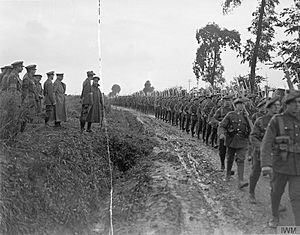
The Second World War
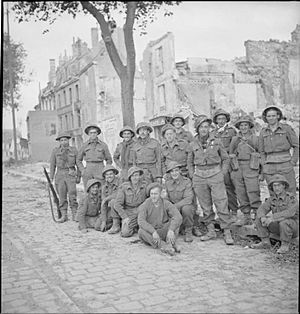
Between the two World Wars, the KOSBs served in places like Ireland, Egypt, and Hong Kong. When the Second World War started in September 1939, they were called back home.
The 1st Battalion went to France and was part of the British Expeditionary Force. They took part in the Dunkirk evacuation in 1940. Later, they were involved in the Normandy landings in 1944 and the Battle for Caen.
The 2nd Battalion served in Burma during the Burma Campaign. They fought in tough battles like the Battle of the Admin Box and the Battle of Imphal in 1944.
The 4th and 5th Battalions also served in France and were evacuated. Later, they helped capture Bremen in Germany. The 6th Battalion joined the Normandy landings and advanced into Germany.
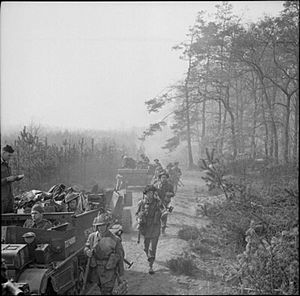
One of the hardest battles for the KOSBs was the Battle of Arnhem in September 1944. The 7th Battalion suffered huge losses, with 90% of its soldiers becoming casualties. They bravely defended their position against strong enemy forces.
After the Wars: Post-War Service
After the Second World War, the regiment helped keep peace in Mandatory Palestine. Around 1948, it became a single battalion.
The KOSBs were part of the United Nations forces in the Korean War. They fought in the First Battle of Maryang San in 1951. Private Bill Speakman was awarded the Victoria Cross, a very high honor, for his bravery during the Second Battle of Maryang-san. The regiment also served in the Malayan Emergency in the late 1950s.
In the 1960s, the KOSBs were sent to Aden and Borneo to help with security. They also served many times in Northern Ireland as part of Operation Banner during a period known as the Troubles. Sadly, two of their men were killed in an attack in 1989. The regiment also took part in the Gulf War in 1991 and Operation Telic in Iraq in 2003.
Joining Forces: The Regiment's Final Years
For a long time, the King's Own Scottish Borderers was one of the few regiments that had never merged with another. However, in 2006, big changes happened in the British Army.
On March 28, 2006, five Scottish regiments, including the KOSBs, joined to form the Royal Regiment of Scotland. Initially, the KOSBs and Royal Scots battalions kept their separate identities. But soon after, they officially merged on August 1, 2006. The new combined battalion was named the Royal Scots Borderers, 1st Battalion Royal Regiment of Scotland. This brought together two historic regiments into one new unit.
King's Own Scottish Borderers Regimental Museum
You can learn more about the King's Own Scottish Borderers at their Regimental Museum. It is located in Berwick Barracks, Berwick-upon-Tweed.
Honours and Achievements
The KOSBs earned many battle honours for their bravery in different conflicts:
- Namur (1695); Minden (1759); Egmont-op-Zee (1799); Egypt (1801); Martinique (1809); Afghanistan (1878–80); Chitral (1895); Tirah (1897–98); Paardeberg, Second Boer War (1899–1902).
- World War I: Mons, Aisne 1914, Ypres 1914, Ypres 1915, Ypres 1917, Ypres 1918, Loos, Somme 1916, Somme 1918, Arras 1917, Soissonnais-Ourcq, Hindenburg Line, Gallipoli, Gaza.
- World War II: Dunkirk, Sword Beach, Odon, Caen, Arnhem, Flushing, Rhine, Bremen, Burma Campaign (Ngakyedauk Pass, Imphal, Irrawaddy).
- Kowang-San (1951–52); Gulf War (1991).
They also received civic honours:
- Freedom of the town of Dumfries (1953).
Regimental Leaders
The regiment had a special leader called the Colonel-in-Chief. From 1937, this role was held by Princess Alice, Duchess of Gloucester.
Many important officers served as Colonels of the Regiment throughout its history. The first was Lt-Gen. David Melville, 3rd Earl of Leven, who founded the regiment. The last Colonel of the Regiment was Maj-Gen. John Cooper, who served from 2001 to 2006.
Football Team
The 1st Battalion of the KOSBs even had its own football team! They played in the Irish Football League for one season (1903–04) while stationed in Belfast.
Images for kids
-
Sergeant Bill Speakman, who was awarded the Victoria Cross in the Korean War.


